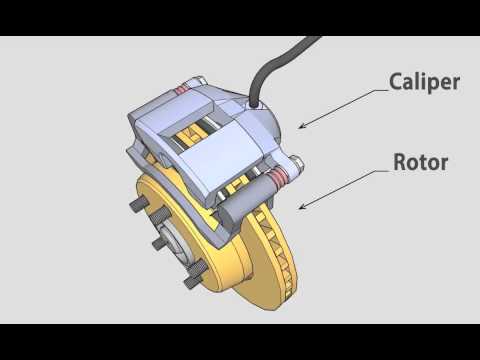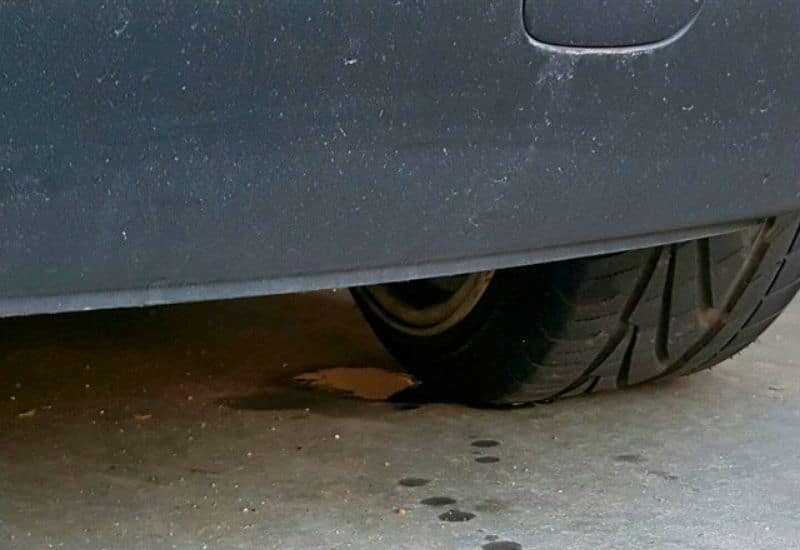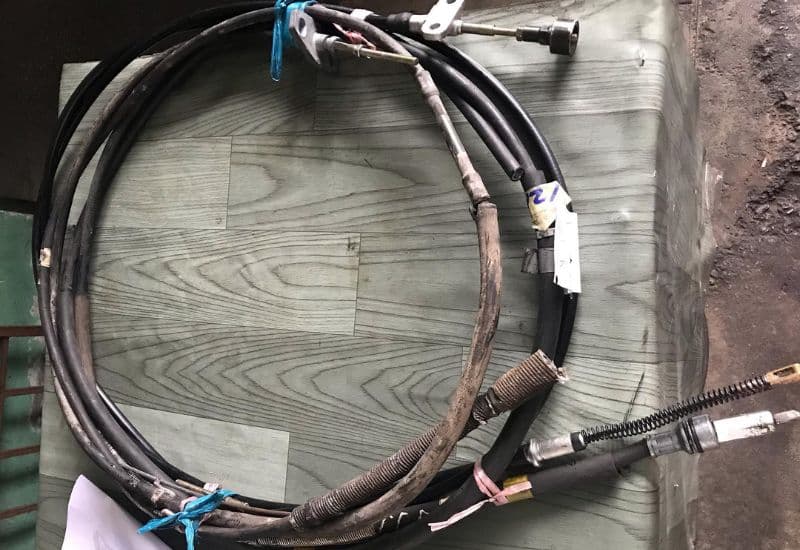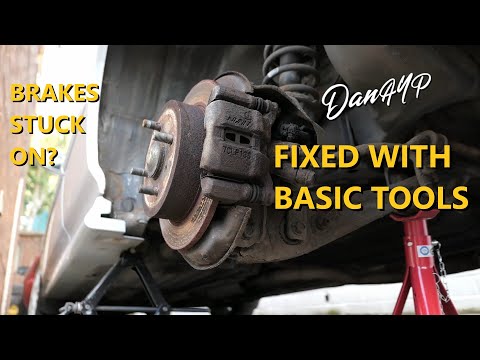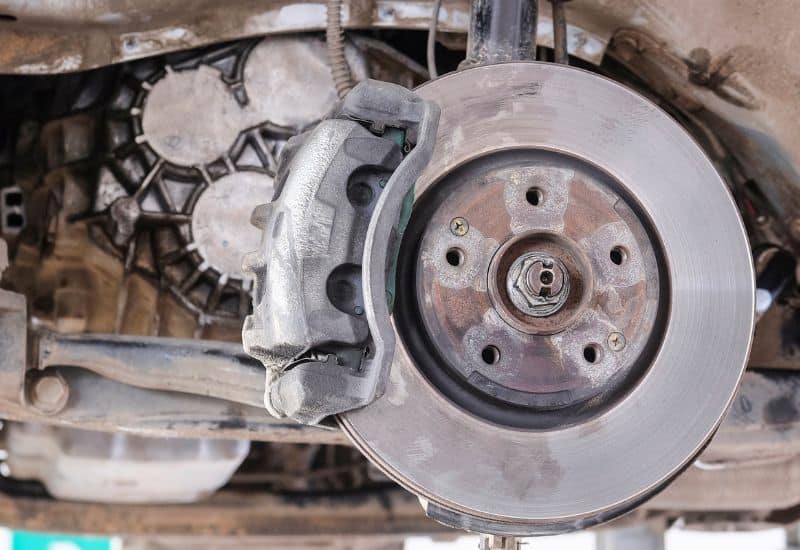
You step on the brake pedal, expecting to come to a smooth stop, only to feel your car suddenly pull to one side. The steering wheel struggles to respond as you try to keep the car out of the ditch. Then you set off again to hear a scraping noise coming from one side, and it feels like the engine just isn’t giving you the full acceleration you demand from the gas pedal.
These are some telltale signs that your car has a sticking brake caliper, which is not what you ever want to procrastinate about.
Knowing what’s causing the brake caliper to stick, how to deal with it, and how to prevent the problem from happening again, requires you to stop long enough to understand how your car’s braking system works.
What Does a Brake Caliper Do?
Each of your car’s brake calipers is a hydraulic clamp that applies pressure to the wheel rotors to create enough friction to stop the car at a reasonable distance. Brake pads buffer direct contact between the calipers and the rotors to prevent damage to the brake system.
The pads are precisely engineered to stay roughly 1 millimeter away from the rotors when the brakes aren’t engaged. The caliper itself activates and deactivates based on pressure supplied by special hydraulic lines.
They respond precisely to how hard and fast you step on the brake pedal. When you step on the pedal, the caliper compresses the brake pads to close the 1-millimeter gap and create sufficient friction with the rotor to slow the car’s brake rotors and wheels safely.
The brake caliper has a lot of moving parts, like caliper pistons, which apply the clamping force on both sides and slide pins that direct the movement and help keep the pads in place.
All the moving components inside a brake caliper rely on sufficient lubrication to respond to the hydraulic pressure exerted by the brake lines and master cylinder when you press the brake pedal. A lack of lubrication, corrosion, or a mechanical defect that gets in the way of the natural motion of the caliper can cause it to stick.
What Does It Mean When a Brake Caliper Is “Sticking?”
Sticking is a general term used to describe a brake caliper that either fails to release when you take your foot off the brake pedal or continuously stays in the applied position. It’s most often caused by corrosion, rust, or road debris that prevents the caliper pistons from returning the brake pads to the open position.
9 Signs to Look for to Tell if You Have a Seized Brake Caliper
The signs of a seized or sticking brake caliper can catch you by surprise. Depending on what’s causing the problem, the symptoms of a seized caliper might be intermittent, which can trick you into thinking it was a one-off issue. Only to have it happen again at the worst possible time!
If you’re wondering whether your vehicle has a seized brake caliper, here are some signs and symptoms to look for:
1. The Car Pulls Hard to One Side When Driving
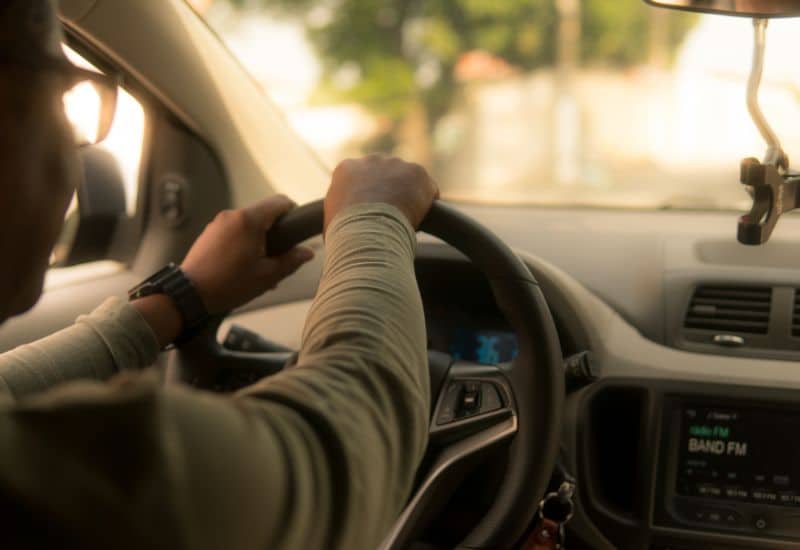
Your car feeling like it’s pulling to one side when you’re driving is one of the earliest and potentially deceptive signs of a sticking brake caliper. At first, dismissing the pull as an alignment issue or even a front-wheel drive torque steer can be easy.
The key difference is that with a seized brake caliper, the pull is usually more noticeable when you first start off after braking and seems to go away. You’ll probably also notice some minor grinding sounds or other symptoms of a brake caliper problem.
2. The Car Pulls Hard to One Side When Braking
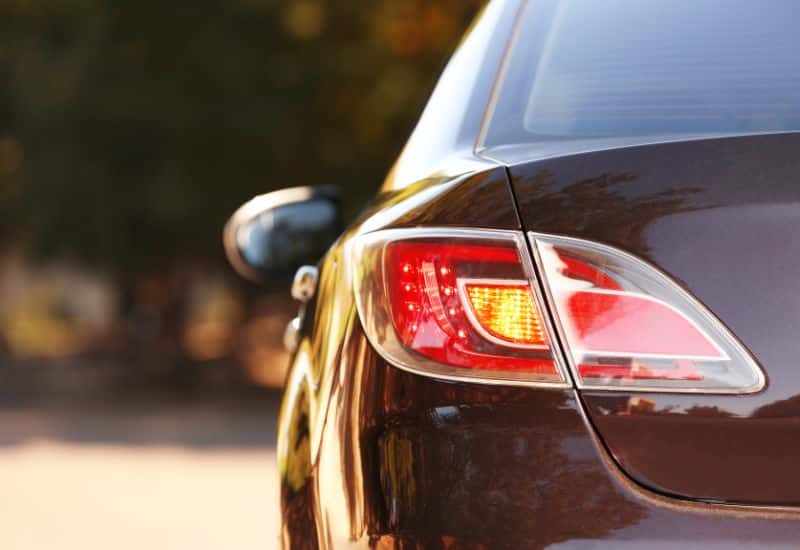
When braking, the car pulling hard to one side is one of the most pronounced early signs of a sticking brake caliper. Depending on what’s causing the caliper to stick, you might notice a slight pull when you step on the brake pedal; the pull gets a little stronger each time you step on the brake pedal. Eventually, you’re pulling desperately on the steering wheel to keep the car out of the ditch or away from oncoming traffic.
However, in some cases, the caliper might not give you any warning at all. It simply locks up when you step on the pedal and pulls violently to one side. Then it grinds horribly when you start off again.
3. Grinding or Rasping Noises When Driving
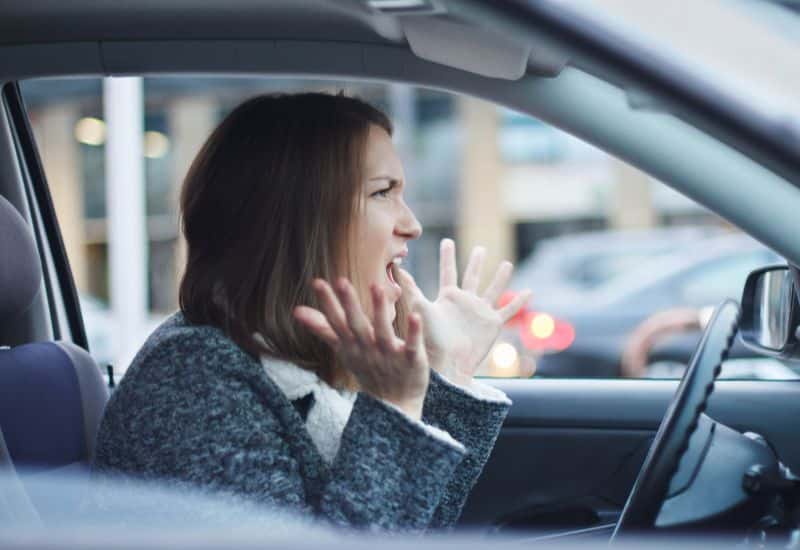
You might have a stuck brake caliper if you hear a metallic grinding or rasping noise immediately after starting off from a stop. Usually, the noise comes from one side of the car and will start out low in cadence, then get lighter and higher as the wheel speed increases. It might seem to vanish completely or disappear into the ambient road noise.
4. Strange Steering Wheel Vibrations
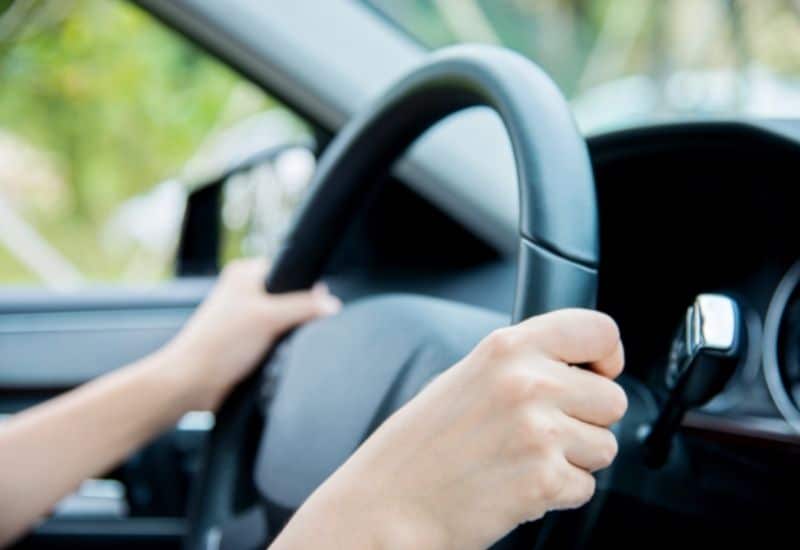
When you step on the brake pedal, a vibrating steering wheel is another common symptom of a stuck brake caliper. The vibration is usually more pronounced in a front-wheel drive car. It might become increasingly noticeable even when driving as the heat and friction start to warp the rotor.
The car will handle it like a shopping cart as it gets worse. It can even feel like something is fighting the steering wheel when you turn a corner in the opposite direction that the car is pulling toward.
5. Strange Burning Smells

Acrid smell and the smell of burning rubber are also common signs of a sticking brake caliper. This is due to the constant heat and friction of the brake pad rubbing against the rotor. It might start as an acrid smell from the amalgam of the super-heated brake pad.
The rubber odor of the rubber brake shims or the rubber piston boot melting is added to the blend. This is also an obvious sign that the sticking caliper is causing increasingly severe damage to the brake pads and the rotor!
6. Heat and Smoke from One Wheel
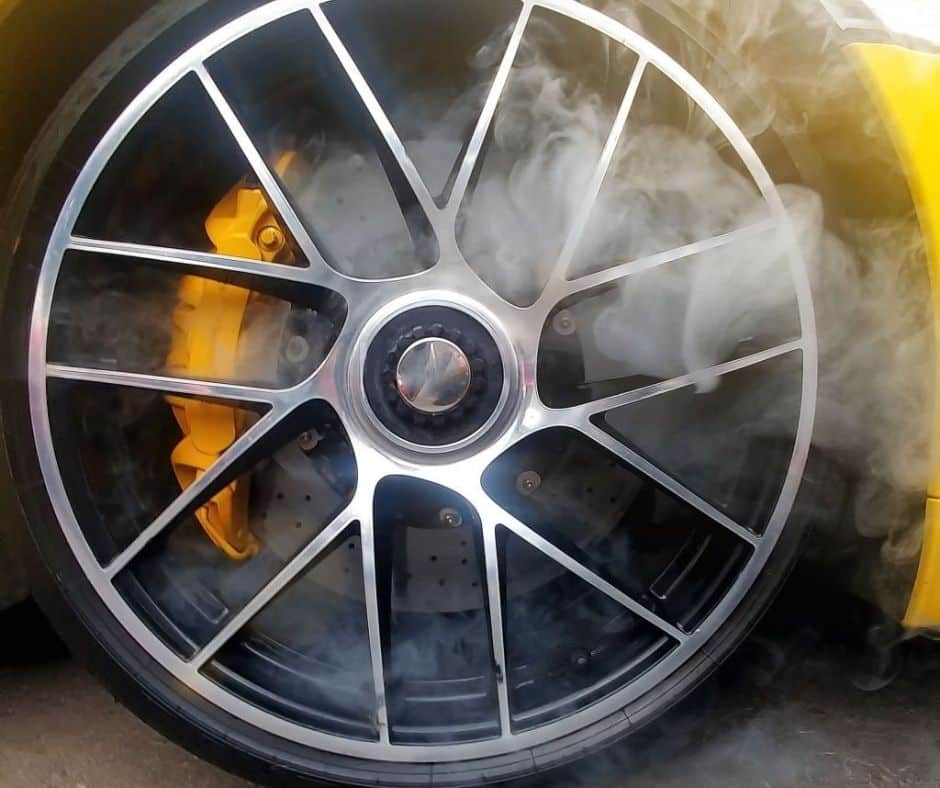
The excess friction caused by a stuck brake caliper can cause a severe buildup of heat in the wheel hub that you might be able to feel by placing your hand near it. If you drive on it long enough, the heat can cause filler materials in amalgam organic brake pads and rubber pad shims to start smoking.
You can use an infrared thermometer to test the temperature of your brakes. Just put the little red dot on the visible brake pad or rotors. If you see one that’s significantly hotter than the other three, you’ll have dialed in which caliper is sticking. This is a simple way to confirm the issue before scheduling a brake inspection.
7. Poor MPG
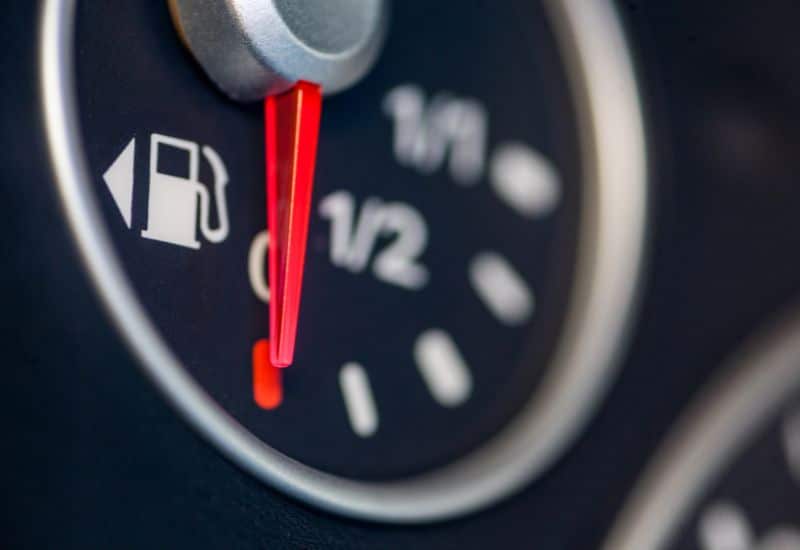
The constant friction of a stuck caliper causes the engine to have to work a little harder to go down the road, which hurts your fuel economy. Poor MPG can be a symptom of a lot of problems. So, if your dash fuel stats are ugly, try to pay attention to other potential symptoms.
8. The Brake Pedal Feels Spongy Before Pulling to One Side
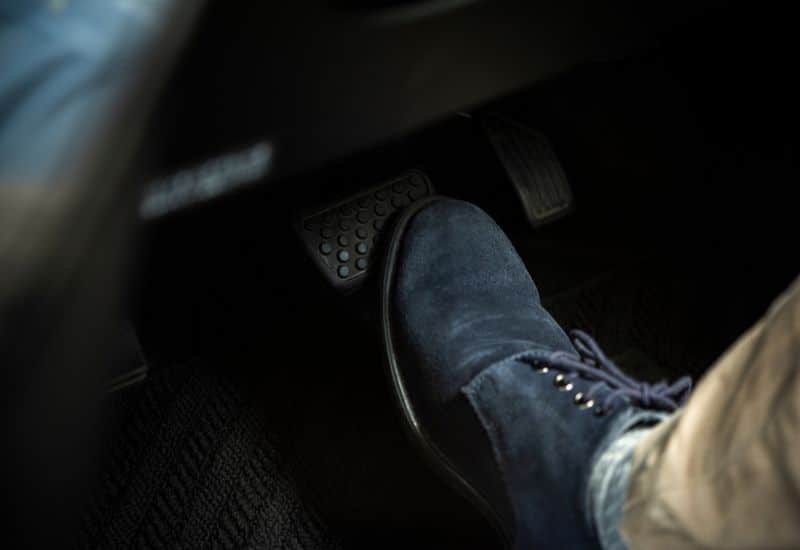
Air in the brake system or a single brake line can cause the brake pedal to feel spongy at first, right before the car pulls to one side. This is due to the air bubble changing the fluid dynamic pressure in the brake lines. It can be caused by improperly bled brake lines from a very recent brake job but is more likely due to a bad brake line or other components that are letting air into the system.
9. Brake Fluid Under One Wheel
Pooling brake fluid under one wheel can also indicate a leaking brake line that affects caliper performance. This can let air into the brake line or drastically affect the brake system pressure, which hampers caliper performance.
This problem tends to get worse in a hurry as the hydraulic fluid in the system starts to bleed out, and you’ll likely notice the brake warning light coming on the dash within the next 3 to 5 times you step on the brake pedal.
Top Reasons Why Your Brake Caliper Is Seizing
Several things can cause a brake caliper to seize, though the top two most common reasons are corrosion on the caliper slides or guides corrode and the caliper piston seizing to the point that it won’t retract even after the brake pedal has been released. These can be standalone causes, but other brake system faults can easily compound them.
1. Lack of Proper Lubrication
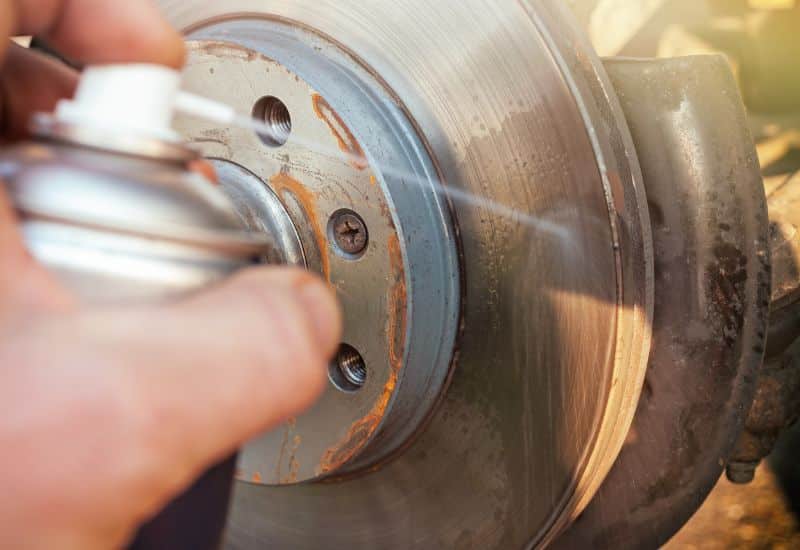
Corrosion caused by poor lubrication on caliper slides, pins, bushings, and contact points where the pads slide within the caliper housing can increase the chances of a brake caliper seizing. This is a somewhat common aftereffect of a rushed DIY brake job. However, it could also be an issue if your car sat in storage for several months.
2. Rusty Brake Pistons and Piston Boots

Failure in the piston boot can cause rust and corrosion on the brake pistons, which can cause the brake caliper to stick. Usually, the brake pistons are protected from road dirt, grime, and the elements by the rubber boot.
However, even a slight tear or the boot coming loose from the caliper housing can let water into the caliper. If the pistons are made from steel, rust and corrosion can prevent them from releasing properly after you take your foot off the brake pedal. If your caliper only has one or two pistons, even a little bit of rust or debris can prevent the piston from releasing properly.
3. Dirty Caliper Guide Pin
Corrosion, rust, or a lack of proper lubrication on the slider pins can cause the brake caliper to be sticky, resulting in some or all of the caliper staying pressed against the rotors. The pins are engineered to let the caliper housing slide freely to evenly even pressure on both brake pads as they come in contact with the rotor. If just one of the slider pins sticks, a portion of the brake pad will remain depressed against the rotor.
4. Improperly Mounted or Rusty Brake Pads
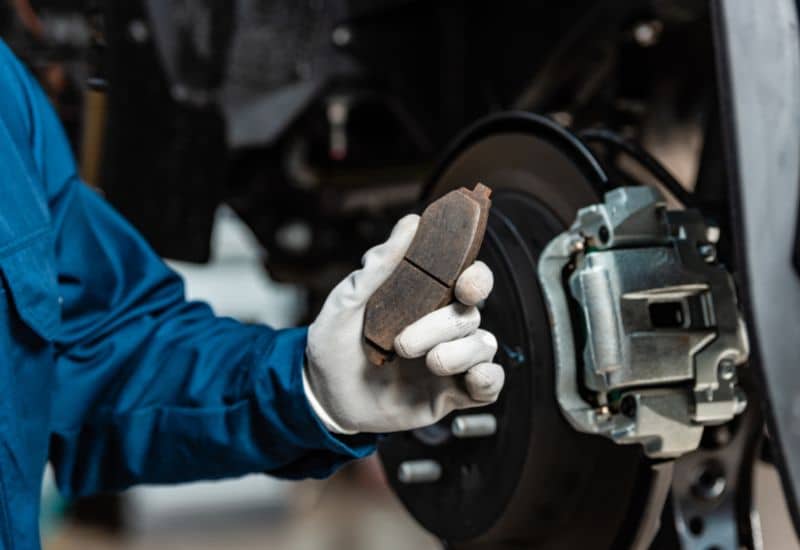
If you recently replaced your own brake pads and didn’t install new pad clips, or you have old, rusty brake pads, it could also cause the caliper to stick on the rotor. This is a common mistake with a lot of DIY brake jobs. In a pinch, you try to reuse the old brake clips or forget to lubricate the pad mounting plate.
As time passes, rust and/or worn-out pad clips can cause the brake pad to contact the rotor incorrectly. When you take your foot off the brake pedal, the pad accidentally stays in place and is held there by the natural tension of the caliper itself. This can cause a persistent grinding noise, and the car might feel like it’s pulling to one side, even when you drive down the road. Eventually, the excess friction can cause severe heat and smoke from the affected wheel.
5. Air in the Brake Line
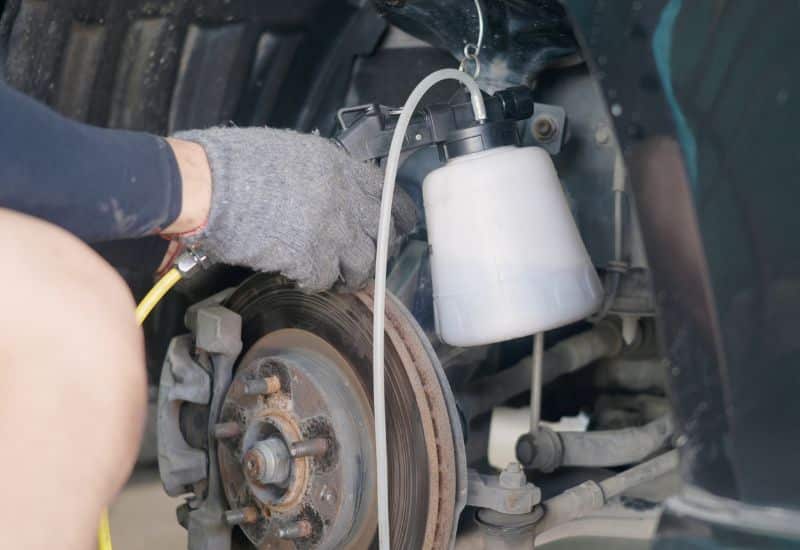
Even a tiny air bubble from improperly bled brakes or a leak in the hydraulic lines or master cylinder can cause a caliper to seize. This is another common aftereffect of a rushed DIY brake job. In a case like this, you’ll often notice that the brake pedal feels a little spongy right before the caliper depresses to stop the car.
When you set off again, the caliper doesn’t immediately respond to the change in hydraulic pressure, keeping the pad pressed against the rotor. This will make the car feel like it’s pulling to one side and might make grinding noises for a few seconds after you take your foot off the pedal.
6. Damaged Brake Hose or Hydraulic Leak
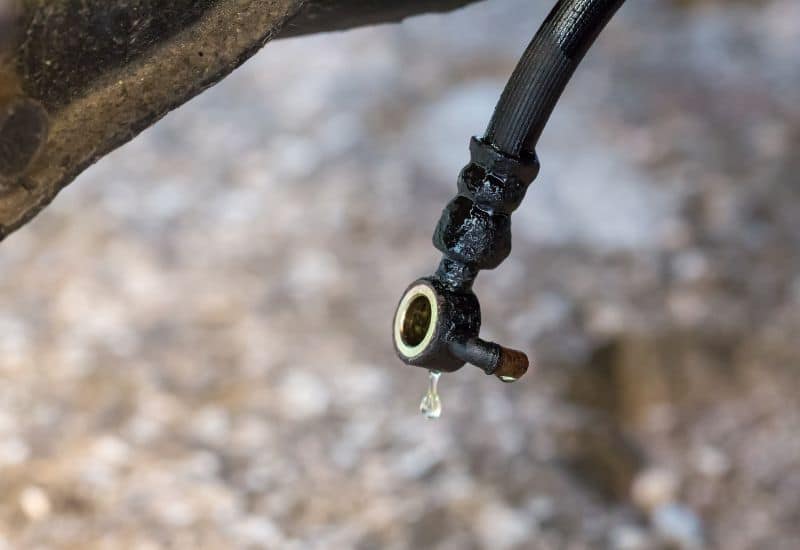
A damaged brake hose or hydraulic leak in the brake system can let air into one or more brake lines, affecting brake caliper performance. Again, you’ll feel a spongy brake pedal with grossly poor braking distance.
Sometimes, a damaged brake hose in the caliper itself will allow hydraulic brake fluid to compress the pistons. Yet the fluid doesn’t flow back when you release the brake pedal, causing the caliper to stay pressed against the rotor.
In a scenario like this, you might notice a small pool of brake fluid under or around one wheel. It will likely worsen every time you step on the brakes to the point that the red brake warning light turns on.
7. Too Much Brake Fluid Causing Brake Drag
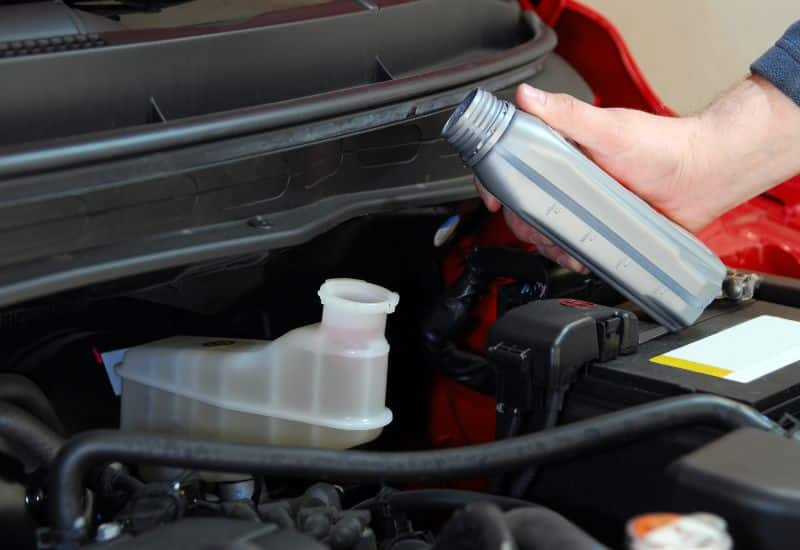
If you add too much brake fluid to the reservoir, the excess hydraulic pressure can cause brake drag, which affects caliper performance. In a case like this, the excessive hydraulic fluid pressure keeps the caliper pistons from fully releasing the caliper and brake pads.
If the brake drag is limited to just one or two wheels on one side of the car, you’ll feel strong pulling when you step on the brakes. When you start off again, the car will still lurch toward that side, even after you take your foot off the brake pedal. A lot of times, brake drag causes all four calipers to be slightly sticky, allowing the car to stop normally, but when you start out again, it’s stubbornly sluggish. You’ll also probably notice the dashboard throwing up poor MPG stats without any mechanical fault to the engine.
If your sticky caliper symptoms are being caused by brake drag, you’ll probably see brake fluid all the way up in the neck of the reservoir. This is a common face-palm moment experienced by many people who do their own brake job. The quick fix is using a turkey baster or a medicine syringe to extract the brake fluid down to the full line.
8. Contaminated or Old Brake Fluid
Old brake fluid contaminated by water can cause rust inside the brake caliper components causing the caliper to stick. Brake fluid has a limited lifespan and should be changed with each brake job.
In a scenario like this, you might experience a brake caliper sticking once or twice on one wheel and freeing itself eventually. Then, a few weeks or months later, another caliper starts sticking. It can leave you feeling like there are gremlins in your brake system when, really, it’s just that you forgot to replace your brake fluid during your last DIY brake job.
9. Corroded or Rusted Handbrake Cables
If your car has a mechanical handbrake, it’s possible for the control cables to rust so bad that the calipers won’t deactivate even when you release the handbrake handle. This was once a very common problem with cars, especially pickup trucks with rear drum brakes, but it can still happen in older vehicles today.
Let’s say you pull up to park on a steep incline, thinking it’s better to be safe than sorry; you pull the handbrake. When you get back to the car, you pop the handbrake and the little button on the handle, or the release switch comes away harder than usual. You might even think, “Well, I haven’t used the handbrake in a while, no big deal!”
Then you set off, and the car feels a little sluggish. You might even hear a strange hum or grinding noise from the back of the car that seems to disappear into the ambient road noise. Then you get out, and the back end of your car smells acrid, and there might even be smoke or noticeable warmth coming from the back wheels.
Can You Free up a Stuck Brake Caliper?
If the brake caliper is seizing from a minor case of rust on the caliper pistons or caliper slides, or you’re dealing with sticky calipers caused by brake drag, you might be able to unstick it yourself. For more serious problems like severe rust or air getting in the brake lines, you’ll probably need a mechanic to replace the bad caliper and repair any other brake system.
How to Unstick a Rusted Brake Caliper
In the case of rust or corrosion, unsticking the caliper starts with jacking the car up, blocking it off, and removing the wheel. Then carefully spray some non-chlorinated brake cleaner like Berryman 2420 non-chlorinated brake parts cleaner on the caliper’s moving parts.
Give the brake cleaner a few minutes. A light tap or two with a hobby hammer might free the caliper. Test it with a few presses of the brake pedal. You can give the sticky caliper a thorough lube job if it moves again. Though you don’t use oil or conventional grease, you need to avoid accidentally lubricating the brake pads or rotors.
Ideally, use a synthetic, non-petroleum, or silicone-based lubricant for rubber or plastic caliper components, such as brake shims or piston boots. If you’re seeking a recommendation, I suggest purchasing Ceramic Extreme Brake Parts Lubricant on Amazon.
When lubricating any metal-to-metal brake surfaces, using a dry film lubricant with a graphite or molybdenum disulfide base is best. This includes the caliper piston(s), slides, or brake pad clips. My preferred choice for this purpose is CRC Extreme Duty Silicone Lubricant 03030.
Unsticking a Brake Caliper Caused by Brake Drag
If you recently tried to tackle your own brake job, or you know you added brake fluid to the reservoir in the past and then had new brake pads installed, then you might be dealing with a case of brake drag. You must extract some brake fluid from the reservoir with a syringe or an old turkey baster. You want to get the brake fluid out of the next and on the full line.
Can You Change Just One Brake Caliper?
If you catch the sticking brake caliper as soon as the problem starts, and it’s one of the rear brakes, you might get away with replacing just the one bad caliper. Though it’s usually wise to replace both calipers on an axle. Especially if the front brakes can bear 60 to 70% of the brake force.
If you replace one front brake caliper, there’s usually a noticeable braking imbalance. This shows up as either delayed braking or the car pulling when you step on the brakes.
How Much Does It Cost to Fix a Sticking Caliper?

If you want to replace the brake sticking caliper yourself, then you’re looking at a parts cost of around $150 to $250 for two calipers. You’ll need to replace both calipers on the axle to keep the braking force even, which will eat up most of your Saturday afternoon.
If you take the car to a mechanic to have both brake calipers replaced, then you can expect another $150 to $250 of labor time added to the cost for a total of $300 to $500 for dual caliper replacement.
These are just the cost of a caliper replacement. Most of the time, a sticky or seized brake caliper damages other braking system components. Don’t be shocked if you also need to have the rotors replaced.
How to Prevent Brake Caliper Seizure?
Preventing brake calipers from seizing starts with having a routine brake inspection performed at least once a year. Most places that offer tire rotation can perform a brake inspection for $50 or less, depending on if you’re subscribed to the service plan. This inspection will spot things like a damaged piston boot or rust on the brake components before it becomes a major problem.
If you’re doing your own brake job, then lubricating all the parts with the proper type of lubricant is also essential to preventing a brake caliper from sticking. Then, you need also to make sure you’re replacing the brake fluid and properly bleeding all the lines.
Keeping an eye on your brake fluid reservoir might also help you catch signs of a brake system problem that can lead to a stuck caliper. If the brake fluid is too high in the reservoir after a brake job, you could experience brake drag. If it’s too low, then the reservoir is telling you that brake fluid is escaping somewhere in the sealed hydraulic lines, which will definitely start to affect how the caliper behaves when you step on the brake pedal.
Frequently Asked Questions
Is It Safe to Drive with a Sticking Brake Caliper?
A sticking or seized brake caliper can be very dangerous to drive on. Not only does it affect the car’s handling, which can pull you into the ditch or the oncoming lane. It can also cause severe damage to the rotor and even damage the transmission. There’s also a risk of fire from excess heat in the wheel.
Can you spray WD-40 on brake calipers?
WD-40 might be a quick fix for a sticking brake caliper if you’re dealing with minor corrosion or debris on the caliper pistons of the guide pins. Just ensure you don’t get any on the rotors or the brake pads, as it will affect friction and braking performance.
Keep in mind that WD-40 is a temporary quick fix. Ideally, you want to take the time to go through and properly lubricate all the brake caliper components with the brake pads out of the way.
Can Road Debris Cause a Caliper to Stick?
If you drive on a lot of gravel roads, there’s a chance that a small pebble or chunk of sand can bounce up into your brake system. This can essentially wedge between the brake pad and the rotor itself, mimicking the grinding sound of a stuck brake caliper. Usually, the debris only stays stuck for a few seconds and disintegrates with the heat and friction of braking force.
Brake Caliper Seizure: Don’t Get Stuck
The most obvious symptom of a sticking brake caliper is the car pulling to one side when you step on the pedal. You might also notice persistent grinding and rasping noises coming from one tire, along with excess heat and smoke.
The most common cause of a sticky or seized brake caliper is usually a brake lubrication problem. Especially if you recently had the car in storage or it’s been a long time since your last brake inspection.
You might be able to get the stuck brake caliper to release with some manual manipulation. From there, a thorough lube job with the correct lubricants on all the moving parts might keep the caliper from sticking again.
Usually, when you suffer a sticky brake caliper, the underlying problem, like a damaged piston boot or corrosion on the other metal components, will eventually cause the caliper to seize again shortly. So, be prepared to shoulder the cost of replacing both calipers on that axle to maintain proper braking balance. In the future, you can help prevent sticky brake calipers by performing a brake inspection each year and staying on top of routine maintenance.

Written By
Jason Farrell
Jason Farrell is a certified master technician, the editor of Mechanic’s Diary in Pittsburgh, Pennsylvania. He is ASE (Automotive Service Excellence) certified and earned a Bachelor’s Degree in Automotive Technology from Pittsburg State University. With nearly 18 prior years of experience in the automotive field, he has extensive knowledge about Domestic, European, and other foreign makes and models of cars and light trucks. Jason’s experience working as a technician and service manager at dealerships, gave him the experience and know-how of most aspects of inspection, diagnosis, and repair from engine and drivability to electrical, HVAC, brakes, steering and suspension and everything in between.

